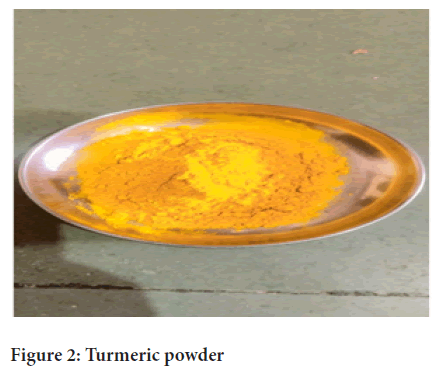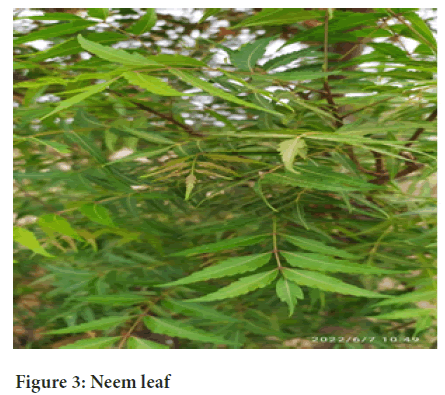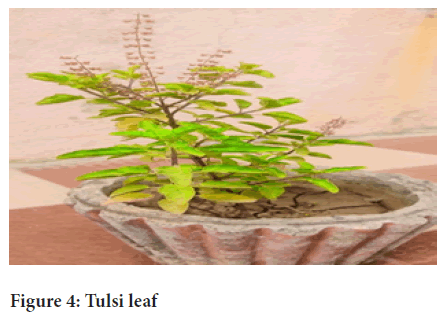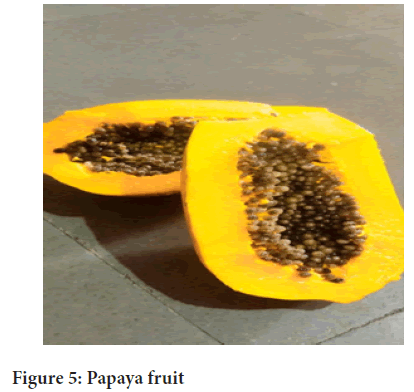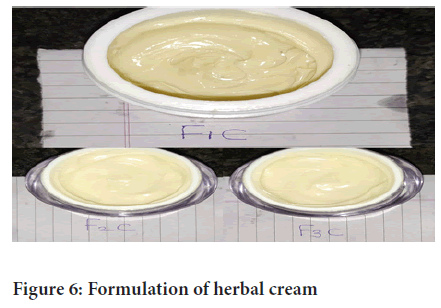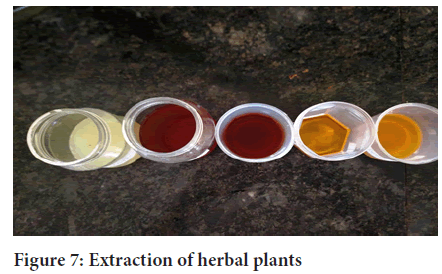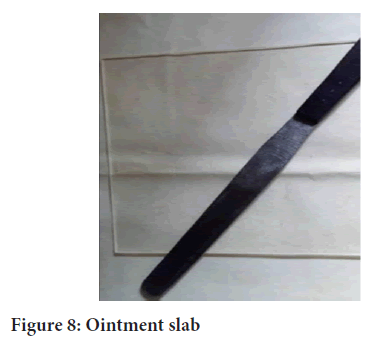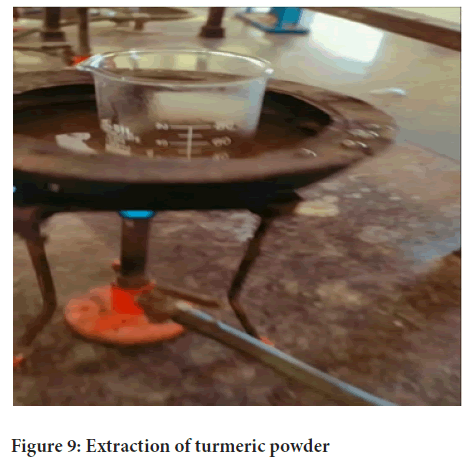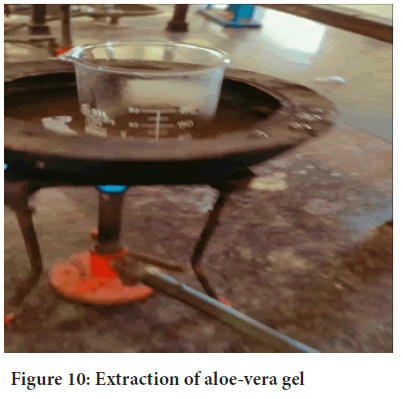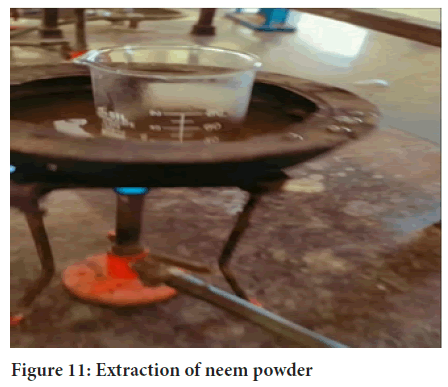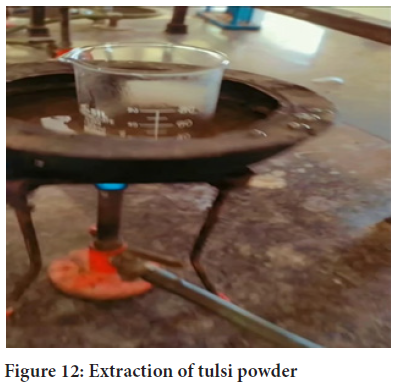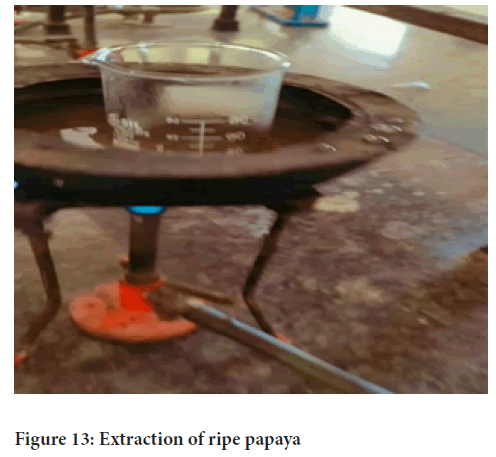Research Article - (2023) Volume 14, Issue 1
Formulation and Evaluation of Multipurpose Herbal Cream
Somnath S Davkhar*, Aarti S Bhandari and Sanjivani A AkolkarAbstract
Herbal cosmetics are products that are used to improve one’s look. The goal of the research was to develop a herbal cream for moisturizing, nourishing, whitening, and treating various skin diseases. Curcuma longa (Turmeric powder), Carica papaya (Papaya), Aloe barbadensis (Aloe-vera leaves), Azadirachta indica (Neem leaves), and Ocimum sanctum (Tulsi leaves) are some of the basic drugs used to make the cream. The selection of components is based on the agents’ various therapeutic characteristics. Various evaluation parameters are used to the cream.
Keywords
Cosmetic, Herbal cream, Turmeric, Papaya, Aloe-vera, Neem, Tulsi
Introduction
The demand of cosmetics due to the availability of herbal cosmetics is increasing predominantly. Herbal formulations are receiving more concentration in public because of their high-quality properties and less side effects. Additionally it also provides the skin with necessary nutrients and required moisture (Mali AS, et al., 2015). The herbal cream is basically water in oil type of emulsion. The natural ingredients chosen for preparation of herbal cream are turmeric, papaya, aloe-vera, tulsi, and neem. The choice of these ingredients is based on their individual properties. Aloe-vera is used as a moisturizer and anti-acne agent (Christaki EV and Florou-Paneri PC, 2010) (Figure 1). Turmeric is an Asian cosmetic useful to impart a golden radiance to the complexion. It also provides anti-inflammatory and antiseptic properties (Dhyani A, et al., 2019) (Figure 2).
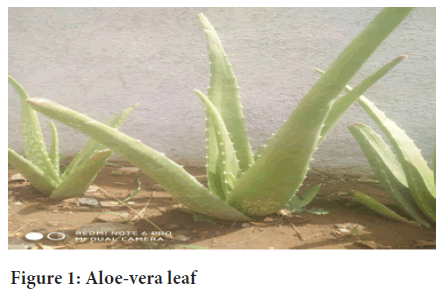
Figure 1: Aloe-vera leaf
Figure 2: Turmeric powder
Neem is helpful against a wide range of skin, disease including eczema, psoriasis, and dry skin (Bhowmik D, et al., 2010) (Figure 3). Tulsi is used to add glow to the skin and to promote wound healing (Figure 4). In addition to these health promoting properties, tulsi is recommended as a treatment for a range of condition including anxiety, cough, and skin diseases (Sah AK, et al., 2018). Papaya is used to the anti-wrinkle cleansing, enzymes action and anti-inflammatory (Figure 5). The main aim of our work is to develop an herbal cream which can give as multipurpose effect like moisturizer, reduce acne and skin irritation, dry skin, wrinkle, rashes, etc. Cosmetic are the products applying on the body.
Figure 3: Neem leaf
Figure 4: Tulsi leaf
Figure 5: Papaya fruit
Face cream are used as cosmetic for softening and cleansing action. The Ayurvedic system of medicine was one of the most important systems that uses herbal plants and extract of the treatment of managements of various disease state (Viswanathan MV, et al., 2003) (Figures 6 and 7). An emulsion is a system in which one fluid is dispersed in another with which it immiscible. Macroscopic separation of phase is prevented by addition of a suitable surfactant (Imhof A and Pine DJ, 1997).
Figure 6: Formulation of herbal cream
Figure 7: Extraction of herbal plants
Water-in-oil emulsion is employed more widely for the treatment of dry skin and emollient application (Mohamed MI, 2004). Additional value can be given to this formulation by including active ingredient with specific cosmetic effects. Particularly advantages cosmetic emulsion preparation is obtained when antioxidants are used as active ingredients (Bleckmann A, et al., 2021).
The function of skin cream is to protect the skin against different environmental condition, weather and gives soothing effect to skin. There are different types of cream like cleansing, cold, foundation, vanishing, night, massage, hand and body creams. The poly herbal cosmetic formulation is receiving recognition all over the world, as they give the enhanced feeling of purity, protection and effectiveness. A large quantity of cream exists in the bazaar use synthetic polymers, emulsifiers, perfuming agents, pigments, surfactant and thinkers to form the base. There is wide need to substitute toxic synthetic agents from base using natural agents (Kapoor S and Saraf S, 2010).
Benefits of turmeric in health
• Natural anti-inflammatory compound
• Improve heart health and prevent against alzheimer’s and cancer
• Powerful antioxidant
• Treat and prevent diabetes
• Improve skin health
• Treats depression
• Cures acne
• Reduce dark circles
• Could help psoriasis eczema
• Clears the skin
• Helps wound healing
• Promotes weight loss
• Protect your body from free radicals
• Anti-microbial agent
Benefits of aloe-vera for face
• Its anti-inflammatory properties can reduce pain, swelling, and soreness of wounds or injuries
• It has a cooling effect on rashes or sunburns
• It supports the production and release of collagen
• Help in keeping your face health and gives you a natural shine
• Aloe-vera is rich in moisturizing properties it helps in removing dead cells
• Prevent or reduce wrinkles and dark spots of your face
• Moisturizes dry skin
• Soothes irritated skin
• Remove sign of ageing
• Fights acne and blemishes
• Remove dark circles and puffiness
• Relieves eczema and psoriasis
• Eliminates dead skin cells
• Treat sunburn
• Bring a natural glow to the skin
• Hydrated the skin with essential
• Prevents premature aging
• Reduce stretch marks
Benefits of neem leaf powder
• Acts as a shield against dandruff
• It can be used for both face and hair
• Treat dry scalp making it smooth and shiny
• Increase radiance and produce ageing effect
• Increase blood circulation
• Help to treat ulcers
• Keep the skin healthy and glowing
• Neem has anti-bacterial properties which get rid of pimples
• Neem lightens and blurs the scars left behind by acne
• Neem is anti-inflammatory in nature with fatty acids and glycosides
• Neem is rich in anti-oxidant and vitamin E that reduce wrinkles
• Fatty acids and vitamin E in neem nourish the skin
• Help soothe eczema
• Treat acne
• Prevent skin infection
• Gives even skin tone
• Offers anti-ageing benefits
Benefits of tulsi leaf powder
• Natural immunity booster
• Reduce stress and blood pressure
• Good for skin health
• Useful in kidney stone
• Fight acne
• Supports healthy skin aging
• Soothes skin condition like eczema
• Great for healing skin problem
• Good source of vitamin K
• Super beneficial for skin
• Helping anti-aging
• Control blood glucose level
• Prevent kidney stone
• Reduce stress
• Prevent acne
Benefits of papaya for skin
• It used to the winkle reduction
• It is used to the enzyme action
• It used to the anti-inflammatory properties
• Control acne
• Remove dead skin cells
• Improve skin stone
• Soothes irritated skin
• Hydrates dry skin
• Help weight loss
• Supporting skin health
• Skin and healing
• Boosts your immunity
• Full of anti-oxidants, vitamin and minerals
• Protect eye sight
• Helps treat hypertension
• Anti-aging properties
• Cures skin infection
• Prevents wrinkles
• Treat morning sickness
Materials and Methods
Collection of plants material
Turmeric, papaya, aloe-vera, tulsi, and neem were collected from local botanical garden. Irrespective of the type of crude drug and area of collection, there cannot be two opinions that drug are collected suitably when they contain maximum concentration of active ingredients.
The advantage of existing environment condition is also taken into consideration while collecting the crude drugs while collecting the natural drugs on commercial scale, attention should be paid for the use of skilled labour. The fruits are collected depending upon the part of fruit used. They collected either ripe or half ripe, but full grown. Rhizomes are collected, when they stored ample of reserve food material and contain maximum content of chemical constituent.
Opium and papaya latices are collected after coagulation of latex. Plant collecting is the acquisition of plant specimens for the purpose of research, cultivation, or as a hobby. Plant specimens may be kept a live but are more commonly dried and pressed to preserve the quality of the specimens. Plant collecting is an ancient practice with records of a Chinese botanist collecting roses over 5000 years ago. These plants usually ended up in botanical gardens or the private gardens of wealthy collectors. They can also provide biological materials for researchers, a reference point to documents scientific names and vouchers, is being used in herbaria across the world. Plant samples in herbaria typically include a reference sheet with information about the plant and details collection. This detailed and organized system of failing provides horticulturist and other researchers a like with a way to find information about a certain plant, and way to add new information to existing plant sample files. The collection of live plants specimens from the wild, sometimes referred to as plant hunting, is an activity that has occurred for centuries. Herbaria are collection of preserved plants samples and their associated data for scientific purpose.
Methods of preparation
Slab method: The components are mixed until a uniform preparation is attained. One small scale, as in extemporaneous compounding, other will use an ointment mill. If components of an ointment react with metal hard rubber spatula may be used. Put this cream on the slab and add few drops of distilled water if necessary and mix the cream in a geometric manner on the slab to give a smooth texture to the cream and to mix all the ingredients properly. This method is called as slab technique or extemporaneous method of preparation of cream (Ashara K, et al., 2013).
Trituration method: Use for finely divided insoluble powder particles or liquid. Insoluble powder is added by geometric dilution. Liquid is added by making well in center and avoid air pocket formation. Reduce the solid medicament to fine powder medicaments is mixed with small amount of base on ointment slab with a stainless steel spatula until a homogenous products in formed (Ashara K, et al., 2013) (Figure 8).
Figure 8: Ointment slab
Fusion method: Fusion is the act or procedure liquefying or melti`ng by the application of heat. By fusion method, all or some of the components of an ointment are combined melted together and cooled with constant stirring until congealed. Ointment base are melted decrease order of their melting point. Highest melting point should be melted first low melting point next. This avoid over heating of substance of low melting point incorporate medicament slowly to the melted mass stir thoroughly until mass cools down and homogenous products is formed (Ashara K, et al., 2013). The excipients and herbal ingredients used with their roles are presented in the Table 1.
| S. No | Ingredients | Roles |
|---|---|---|
| 1 | Turmeric | Glow your skin and antiseptic, anti- inflammatory |
| 2 | Ripe papaya | Anti- wrinkle, cleansing, enzymes action, anti- inflammatory |
| 3 | Aloe-vera | Anti-ageing, reduce acne and pimples |
| 4 | Tulsi | Antibacterial, add glow to the face |
| 5 | Neem | Relieves skin dryness promote wound healing |
| 6 | Bees wax | Emulsifying agent |
| 7 | Liquid paraffin | Lubricating agent |
| 8 | Borax | Alkaline agent |
| 9 | Methyl paraben | Preservative |
| 10 | Distilled water | Vehicle |
| 11 | Rose oil | Fragrance |
Table 1: Excipients and herbal ingredients used with their roles
Results and Discussion
Extraction process
Preparation of turmeric extract: Take 1 g turmeric powder in 10 ml distilled water and shaken in 250 ml volumetric flask heated in water bath at 80°C to 100°C for 5 to 10 minutes. Then filtered it and it and turmeric extract is obtained (Figure 9).
Figure 9: Extraction of turmeric powder
Preparation of aloe-vera extract: Collect mature and fresh aloe-vera leaf from plant and washed it with distilled water. Dried it is hot air oven. Leaf dissected longitudinally by sterile knife. The semi-solid aloe-vera is collected. Remove fibers and impurities form it. Aloe-vera extract is obtained (Figure 10).
Figure 10: Extraction of aloe-vera gel
Preparation of neem extract: Collect fresh neem leaves and wash it with distilled water. Dried it in hot air oven and then powdered take 5 gm neem powder in 20 ml Dimethyl sulfoxide at 100°C for 5 to 10 minutes. Then filter it by filter paper and clear solution is obtained (Figure 11).
Figure 11: Extraction of neem powder
Preparation of tulsi extract: Tulsi leaves were collected and washed with distilled water and dried hot air oven. Then after proper drying, the leaves were powdered. Then 1 gm tulsi leaf powder+10 ml Dimethyl sulfoxide was taken in a volumetric flask. Then the solution was heated on water bath at 80°C to 100°C for 5 to 10 minutes then filtered the solution use by filter paper and clear extract of tulsi leaves (Figure 12).
Figure 12: Extraction of tulsi powder
Preparation of ripe papaya extracts (papaya oil): To make the papaya oil, take a tablespoon of every finely cut, ripe but firm organic papaya, pieces in a bowl. Add in 2 tablespoon of any unrefined oil of your choice now take the bowl and place it over a pan of gently simmering water. The top bowl with the oil should not touch the water in the bottom bowl and the flame should be on the lowest possible setting the entire time we’re making the oil. Continue cooking like this for 30 minutes using double boiler method will help preserve to top up with water every 10 minutes. After 30 minutes remove the top bowl and strain out the oil. Now you make the papaya oil is obtained (Figure 13).
Figure 13: Extraction of ripe papaya
Formulation of cream
Take the liquid paraffin and bess wax in a borosilicate glass breaker at 75°C and maintain that heating temperatures (oil phase). In other beaker, dissolve borax and methyl paraben in distilled water by maintaining temperatures 75°C with water bath. Stir the solution with glass rod until all solid particles get dissolve (Aqueous phase). The gently add heated aqueous phase in heated oily phase with continue stirring (Ashara K, et al., 2013). After mixing both phases, immediately add aloe-vera extract, neem extract, tulsi extract, and turmeric extract and add ripe papaya into it with continues mixing by glass rod until it forms a smooth cream (Table 2). When cream is formed, then add rose oil as fragrance. Put this cream on the slab and add few drops of distilled water if necessary and mix the cream in a geometric manner on the slab to give a smooth texture to the cream and to mix all the ingredients properly. This method is called as slab technique or extemporaneous method of preparation of cream.
| S. No | Ingredients | Formulation code | ||
|---|---|---|---|---|
| F1HC | F2HC | F3HC | ||
| 1 | Turmeric extract | 2.7 ml | 1.42 ml | 1.67 ml |
| 2 | Ripe papaya | 2.7 ml | 1.67 ml | 1.42 ml |
| 3 | Aloe-vera extract | 2.8 ml | 1.47 ml | 1.67 ml |
| 4 | Tulsi extract | 1.7 ml | 1 ml | 1 ml |
| 5 | Neem extract | 0.9 ml | 0.28 ml | 0.67 ml |
| 6 | Bee-wax | 5.45 gm | 4.97 gm | 5.36 gm |
| 7 | Liquid paraffin | 18.1 ml | 21.32 ml | 20.1 ml |
| 8 | Borax | 0.36 gm | 0.56 gm | 20.1 gm |
| 9 | Methyl paraben | 0.03 gm | 0.59 gm | 0.50 gm |
| 10 | Distilled water | q.s. | q.s. | q.s. |
| 11 | Rose oil | q.s. | q.s. | q.s. |
Table 2: Formulation table
Physical parameters
In this test color, odor, texture, and state of cream are observed (Navindgikar N, et al., 2020).
Irritancy: Mark the area (1 cm2) on the left hand dorsal surface. Then the cream was applied to the area and the time noted. After interval up to 24 hr. it is checked for irritant effect, erythema and edema if any than reported (Navindgikar N, et al., 2020) (Tables 3 and 4).
| S. No | Parameters | F1C | F2C | F3C |
|---|---|---|---|---|
| 1 | Color | Faint yellow | Faint yellow | Faint yellow |
| 2 | Odor | Pleasant | Pleasant | Pleasant |
| 3 | Texture | Smooth | Smooth | Smooth |
| 4 | State | Semi-solid | Semi-solid | Semi-solid |
Note: F1C: Pharmacy 1 cream; F2C: Pharmacy 2 cream; F3C: Pharmacy 3 cream
Table 3: Physical parameters
| S. No | Formulation | Irritant effect | Erythema | Edema |
|---|---|---|---|---|
| 1 | F1C | Nil | Nil | Nil |
| 2 | F2C | Nil | Nil | Nil |
| 3 | F3C | Nil | Nil | Nil |
Note: F1C: Pharmacy 1 cream; F2C: Pharmacy 2 cream; F3C: Pharmacy 3 cream
Table 4: Irritancy test
Wash ability: Wash ability test was carried out by applying a small amount of cream on the hand and then washing it with help of tap water. All three formulations were easily washable (Navindgikar N, et al., 2020) (Table 5).
| S. no | Formulation | Wash ability |
|---|---|---|
| 1 | F1C | Easily washable |
| 2 | F2C | Easily washable |
| 3 | F3C | Easily washable |
Note: F1C: Pharmacy 1 cream; F2C: Pharmacy 2 cream; F3C: Pharmacy 3 cream
Table 5: Wash ability test
Phase separation: Prepared cream is kept in tightly closed container at room temperature away from sunlight and observed for 24 hours for phase (Navindgikar N, et al., 2020) (Table 6).
| S. No | Formulation | Phase separation |
|---|---|---|
| 1 | F1C | No phase separation |
| 2 | F2C | No phase separation |
| 3 | F3C | No phase separation |
Note: F1C: Pharmacy 1 cream; F2C: Pharmacy 2 cream; F3C: Pharmacy 3 cream
Table 6: Phase separation
pH: Take 0.5 g of cream and dispersed it in 50 ml distilled water. Then check it’s pH by using digital pH meter (Gupta N, et al., 2015) (Table 7).
| S. No | Formulation | PH |
|---|---|---|
| 1 | F1C | 7.98 |
| 2 | F2C | 7.94 |
| 3 | F3C | 7.96 |
Note: F1C: Pharmacy 1 cream; F2C: Pharmacy 2 cream; F3C: Pharmacy 3 cream
Table 7: pH test
Spreadability: Spreadability is carried out for all three formulations that is, F1C, F2C and F3C. The less time take for the separation of both the slide better the spreadability. Therefore according to statement F2C had better spreadability (Rignall A, et al., 2017) (Table 8).
| S. No | Formulation | Time (sec) | Spreadability (gcm/sec) |
|---|---|---|---|
| 1 | F1C | 7 | 2.14 |
| 2 | F2C | 5 | 3 |
| 3 | F3C | 6 | 2.5 |
Note: F1C: Pharmacy 1 cream; F2C: Pharmacy 2 cream; F3C: Pharmacy 3 cream
Table 8: Spreadability test
Conclusion
By using turmeric, papaya, aloe-vera, neem and tulsi the cream showed multipurpose effect and all herbal ingredients were used showed different significant activities. Based on the results we can say that all formulation F1C, F2C and F3C were stable at room temperature and can be a safely used on the skin. Therefore according to statement of F2C is better formulation than F1C and F3C of formulation of herbal cream. The present work focuses on the potential of herbal extract from cosmetic purpose. The uses of cosmetic have been increased in many folds in personal care system. The uses bioactive ingredient in cosmetic influence biological functions of skin and provide nutrients necessary for the healthy skin. The prepared formulation showed good spreadability, no evidence of phase separation and good consistency during the study period.
The prepared herbal cream has best properties and having nutritional values using less chemical which protects the skin from the various skin problem. Since the cream was prepared by using simple ingredients and simple method so the cream is also economical. The herbal cosmetic formulation is safe to use and it can be used as the provision of a barrier to protect skin. The result of different tests of cream showed that the formation could be used topically in order to protect skin against damage. Natural remedies are more acceptable in the belief that they are safer with fewer side effects than the synthetic ones. Further research will carry out to check scientifically the synergistic action of formulation.
References
- Mali AS, Karekar P, Yadav AV. Formulation and evaluation of multipurpose herbal cream. Int J Sci Res. 2015; 4(11): 1495-1497.
- Christaki EV, Florou-Paneri PC. Aloe vera: A plant for many uses. J Food Agric Environ. 2010; 8(2): 245-249.
- Dhyani A, Chander V, Singh N. Formulation and evaluation of multipurpose herbal cream. J drug deliv ther. 2019; 9(2): 341-343.
- Bhowmik D, Chiranjib YJ, Tripathi KK, Kumar KS. Herbal remedies of Azadirachta indica and its medicinal application. J Chem Pharm Res. 2010; 2(1): 62-72.
- Sah AK, Vijaysimha M, Mahamood M. The tulsi, queen of green medicines: Biochemistry and pathophysiology-a review. Int J Pharm Sci Rev Res. 2018; 50(2): 106-114.
- Viswanathan MV, Unnikrishnan PM, Komatsu K, Fushimi H, Basnet P. A brief introduction to Ayurvedic system of medicine and some of its problems. Indian J Tradit Knowl. 2003; 2(2): 159-169.
- Imhof A, Pine DJ. Stability of nonaqueous emulsions. J Colloid Interface Sci. 1997; 192(2): 368-374.
[Crossref] [Google scholar] [Pubmed]
- Mohamed MI. Optimization of chlorphenesin emulgel formulation. The AAPS J. 2004; 6(3): 81-87.
[Crossref] [Google scholar] [Pubmed]
- Bleckmann A, Kropke R, Schneider G, Beiersdorf AG. Preparation of the w/o emulsion type with an increased water content, additionally comprising one or more alkylmethicone copolyols and/or alkyldimethicone copolyols, and cationic polymers. US patent application. 2021.
- Kapoor S, Saraf S. Formulation and evaluation of moisturizer containing herbal extracts for the management of dry skin. Pharmacog J. 2010; 2(11): 409-417.
- Ashara K, Soniwala MM, Paun J, Chawda J. Importance of trituration technique on preparation and evaluation of cold cream. Inventi Rapid Pharm Tech. 2013: 1-2.
- Navindgikar N, Kamalapurkar KA, Chavan PS. Formulation and evaluation of multipurpose herbal cream. Int J Curr Pharm Res. 2020; 12(3): 25-30.
- Gupta N, Dubey A, Prasad P, Roy A. Formulation and evaluation of herbal fairness cream comprising hydroalcoholic extracts of Pleurotus ostreatus, Glycyrrhiza glabra and Camellia sinensis. Pharma Bio Sci J. 2015: 40-45.
- Rignall A. ICHQ1A (R2) stability testing of new drug substance and product and ICHQ1C stability testing of new dosage forms. ICH quality guidelines: An implementation guide. 2017.
Author Info
Somnath S Davkhar*, Aarti S Bhandari and Sanjivani A AkolkarCitation: Davkhar SS: Formulation and Evaluation of Multipurpose Herbal Cream
Received: 02-Dec-2022 Accepted: 27-Dec-2022 Published: 03-Jan-2023, DOI: 10.31858/0975-8453.14.1.23-28
Copyright: This is an open access article distributed under the terms of the Creative Commons Attribution License, which permits unrestricted use, distribution, and reproduction in any medium, provided the original work is properly cited.
ARTICLE TOOLS
- Dental Development between Assisted Reproductive Therapy (Art) and Natural Conceived Children: A Comparative Pilot Study Norzaiti Mohd Kenali, Naimah Hasanah Mohd Fathil, Norbasyirah Bohari, Ahmad Faisal Ismail, Roszaman Ramli SRP. 2020; 11(1): 01-06 » doi: 10.5530/srp.2020.1.01
- Psychometric properties of the World Health Organization Quality of life instrument, short form: Validity in the Vietnamese healthcare context Trung Quang Vo*, Bao Tran Thuy Tran, Ngan Thuy Nguyen, Tram ThiHuyen Nguyen, Thuy Phan Chung Tran SRP. 2020; 11(1): 14-22 » doi: 10.5530/srp.2019.1.3
- A Review of Pharmacoeconomics: the key to “Healthcare for All” Hasamnis AA, Patil SS, Shaik Imam, Narendiran K SRP. 2019; 10(1): s40-s42 » doi: 10.5530/srp.2019.1s.21
- Deuterium Depleted Water as an Adjuvant in Treatment of Cancer Anton Syroeshkin, Olga Levitskaya, Elena Uspenskaya, Tatiana Pleteneva, Daria Romaykina, Daria Ermakova SRP. 2019; 10(1): 112-117 » doi: 10.5530/srp.2019.1.19
- Dental Development between Assisted Reproductive Therapy (Art) and Natural Conceived Children: A Comparative Pilot Study Norzaiti Mohd Kenali, Naimah Hasanah Mohd Fathil, Norbasyirah Bohari, Ahmad Faisal Ismail, Roszaman Ramli SRP. 2020; 11(1): 01-06 » doi: 10.5530/srp.2020.1.01
- Manilkara zapota (L.) Royen Fruit Peel: A Phytochemical and Pharmacological Review Karle Pravin P, Dhawale Shashikant C SRP. 2019; 10(1): 11-14 » doi: 0.5530/srp.2019.1.2
- Pharmacognostic and Phytopharmacological Overview on Bombax ceiba Pankaj Haribhau Chaudhary, Mukund Ganeshrao Tawar SRP. 2019; 10(1): 20-25 » doi: 10.5530/srp.2019.1.4
- A Review of Pharmacoeconomics: the key to “Healthcare for All” Hasamnis AA, Patil SS, Shaik Imam, Narendiran K SRP. 2019; 10(1): s40-s42 » doi: 10.5530/srp.2019.1s.21
- A Prospective Review on Phyto-Pharmacological Aspects of Andrographis paniculata Govindraj Akilandeswari, Arumugam Vijaya Anand, Palanisamy Sampathkumar, Puthamohan Vinayaga Moorthi, Basavaraju Preethi SRP. 2019; 10(1): 15-19 » doi: 10.5530/srp.2019.1.3







